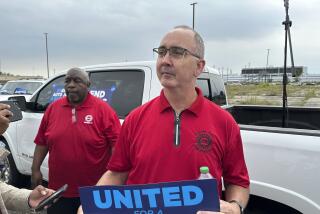VIEWPOINTS : CAN EASTERN AIRLINES BE SAVED? : The Strikebound Carrier Probably Has a Future, but Who Will Lead It--and in What Form--Is Anyone’s Guess
- Share via
E astern Airlines is almost completely grounded by striking union workers and the chance that a buyer can step in and successfully rescue the carrier appears to be dimming. Just last week, former Baseball Commissioner Peter V. Ueberroth abandoned his bid for the airline. Can Eastern Airlines still be saved? And if so, what would its owners need to do to turn the carrier’s fortunes around? Times researcher Melanie Pickett interviewed various authorities about Eastern’s prospects, and excerpts of their comments follow.
Frank Borman, former chairman and chief executive of Eastern Airlines:
“I think it probably can be saved as a smaller airline. I’m not sure that Eastern with its current union leadership, regardless of who is running it, would be a viable enterprise. I think Mr. Ueberroth probably dodged a bullet (when his offer to buy Eastern collapsed). The machinists union particularly has really had as its goal since the early ‘80s to gain control of the airline. I think it is more a power control issue more than it is an economic issue. They (labor leaders) have successfully, I might add, tagged Frank Lorenzo (chairman of Eastern and its parent company, Texas Air) as the bad guy. I think that’s a bum rap. The problem lies not with the ownership there but with the people who are leading the unions.
“Eastern has gone through this before. In the early ‘70s we had one of the worst passenger complaint records in the business. We turned that around and from ’76 to ‘86, we had fewer consumer complaints per 100,000 passengers than any airline but Delta. We had everybody working together and responsible union leadership. You’ve got to understand that that company for a period of almost eight years has now had a consistent negative impact from the machinists union.
“If they rebuild the airline there’s no reason to change the union leadership because the machinists union is out on strike now, and so they’re goodby. The people that want to come back, will come back under a different contract and essentially that would be the end of the machinists union at Eastern Airlines. And that would be the best possible thing that could happen there.”
John Nance, author of “Blind Trust: the Human Crisis in Airline Safety”:
“Eastern Airlines and the people of Eastern have always needed somebody who understands that the primary element of the airline business is that it is a people business. . . . To have a safety system, to have operations go smoothly as well as customer contact and good service, you have to have reasonably content people.
“The one reason that Eastern has been unable to make money has been because its people have been hideously unhappy and have been abused and mistreated and financially undernourished for a lot of years. There’s no other explanation for it because they’re flying the same routes and the same airplanes under the same conditions as Delta Air Lines, which is making money hand over fist.
“You give these people the opportunity to be proud of their carrier and to have a piece of it and they will run circles around Continental Airlines (which, like Eastern, is owned by Texas Air) or anything else managed in the tawdry, people-hating manner of a Frank Lorenzo.
“All an airline is a collection of people working hard. They can create a miracle overnight.” . . . I think most Americans want Eastern to succeed, and I think they’ll be willing to give Eastern a chance just like they gave poor Braniff a chance when it got back in the air. I have great confidence that if these folks are organized properly Eastern will become a dynamo. Delta is going to have some stiff competition.”
Louis Marckesano, an airline industry analyst with the Janney Montgomery Scott investment firm:
“TWA taking over Eastern would still probably be the most attractive solution to the problem in terms of the airline, the employees and the long-term viability of Eastern and TWA. Eastern, even under the Ueberroth plan, had that gone through, would still face potential problems downstream in competing with the larger, more prosperous carriers. Even though Ueberroth’s plan with the concessions would probably have been able to restore profitability at Eastern at some future point, it wouldn’t have guaranteed long-term viability of the company.
“The other plan that has been mentioned has been the downsizing of Eastern, which is really tantamount to selling it off in pieces. It would mean some liquidation and then perhaps the remaining shell probably going into Continental eventually. But it would have to be much smaller before they could do that.
“As an independent carrier, Eastern’s chances would be almost nil. If we’re talking about it as part of a bigger TWA system, I think it would be excellent, that most of the structure could remain in place.”
“The public perception of Eastern had not been that good before the strike. . . . That’s been a problem, probably even more than the labor problems, contributing to the big losses of the last couple of years. The strike has just exacerbated perhaps the public’s perception of the problems at Eastern. Where there are good competitors, it’s going to be hard to get market share back.”
Alan Taylor, senior vice president of Landor Associates, a corporate image consulting firm:
“Eastern’s image is tarnished, certainly, but it is not indelibly harmed. The airline is a company that significant populations in the United States have claimed to love, or love to hate, but in any event have grown up with for three or four decades. It still enjoys, and I’ve seen research that clearly supports this, an immense customer loyalty on the Northeastern corridor, its Florida operations and a very profitable business in its longer haul Latin American routes.
“From an image standpoint, it would behoove Eastern Airlines to be divorced in toto from both the financial control and the identity of Frank Lorenzo. In a way, the personality issue here has been the convenient target for much injustice but also much culpability on the part of employees as well. The fact that Eastern Airlines, to the traveling public time and again in quantitative surveys as well as in terms of government required statistics, performs poorly is as much a function of employee attitude or non-service consciousness, as it is management style, ineptitude or passenger disregard. The plight of Eastern Airlines cannot be laid solely at the doorstep of its owner-operator Frank Lorenzo.”
“There is an immense amount of value . . . in the reputation, history, continued consumer loyalty behind Eastern Airlines. It would be something of a commercial and romantic tragedy were Eastern Airlines to cease operations and go out of business.”
Candace Browning, an airline industry analyst with the investment firm Wertheim Schroder:
“The longer (the strike) goes on the more difficult it’s going to be to revive the carrier because its traffic is slowly but surely being taken away on a somewhat permanent basis by competitors.
“Specifically, lets take a look at Delta, which is carrying only about 30% of Eastern traffic. I think that they will retain a lot of that once Eastern gets back up in the air because they are increasing service in selected Eastern markets and will continue to do so as time goes on. Eastern’s former passengers also will join Delta’s frequent-flier program and they’re going to stick with it afterward. So the longer it goes on, it is less and less likely that you can build up a strong Eastern.”
Henry A. Duffy, president of the Air Line Pilots Assn.:
“First of all, the level of interest by various buyers to come in and purchase what is obviously a troubled airline in bankruptcy tells me that some of the financial people out there think there is a future for Eastern. I know from the employees’ point of view there is this, almost repressed now, desire to get the airline back on a good service footing and I think whoever buys it is going to have the most willing, dutiful employee group that exists in the airline industry. There’s a tremendous family feeling among the strikers out there and I think that converts into good customer service.
“I don’t think the bankruptcy court is going to permit (selling off Eastern’s assets) because I don’t think it’s in the public interest to begin with. Further concentration of the airline industry, the removal of one of the major carriers, I think it’s clearly not in the public interest and I don’t sense from the bankruptcy court any move in that direction. If there is any viable purchaser out there, that’s the direction they’re going to head. If it’s disposed of piecemeal then we’re going to do our best to see that the pilots go with the routes and equipment.
“The great injustice of all of this is--if that worst-case scenario took place that the airline was broken up and we had to place people around the industry--again the employees will have been hurt, Frank Lorenzo will have walked away from this thing with only his reputation damaged, but it’s the inequality of the rules of something like this. He’s managed to sequester many of the assets by upstreaming them into holding companies where the assets can’t be gotten to. The employees don’t have that luxury.”
Dan Smith, director of government and industry affairs for the International Airline Passengers Assn.:
“What they’re going to have to do is to make promises that appeal to the public and then fulfill them. . . . Word of mouth in terms of business passengers is probably the strongest endorsement for any kind of company. It may not be the quickest but it is the strongest. So that once people experience the new Eastern or the new Trump Air the word will get out, as long as they make their promises that appeal to the consumer and deliver them. The phenomenon has worked with Southwest spectacularly.”
More to Read
Inside the business of entertainment
The Wide Shot brings you news, analysis and insights on everything from streaming wars to production — and what it all means for the future.
You may occasionally receive promotional content from the Los Angeles Times.










